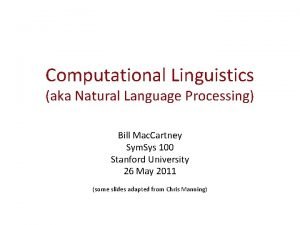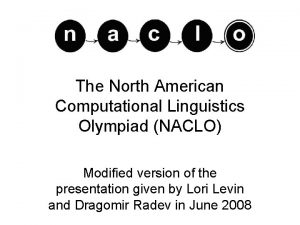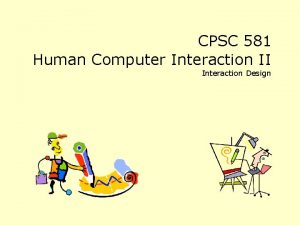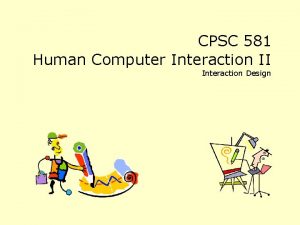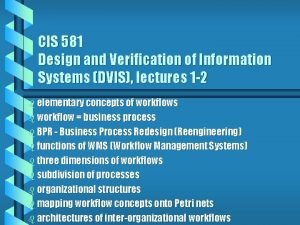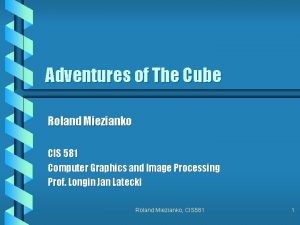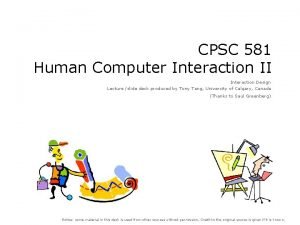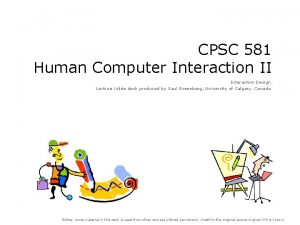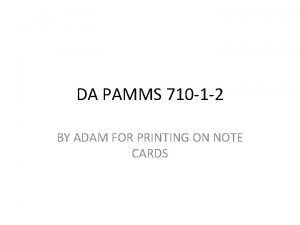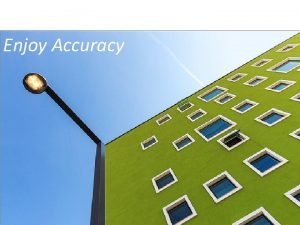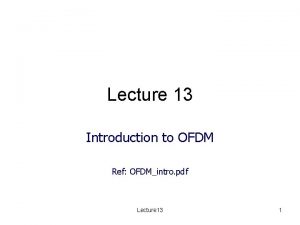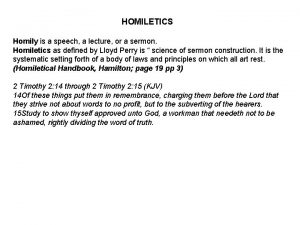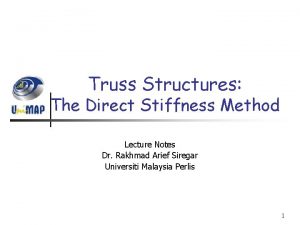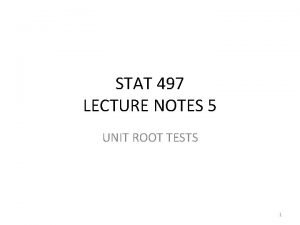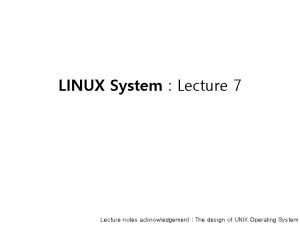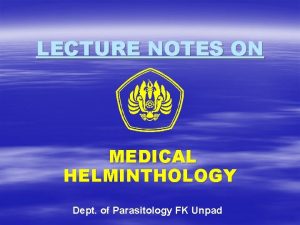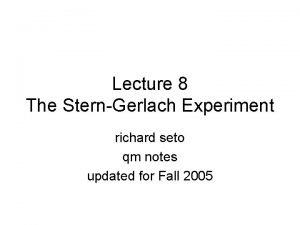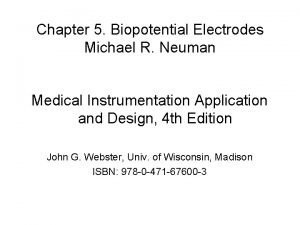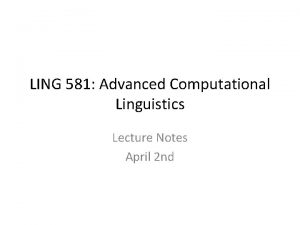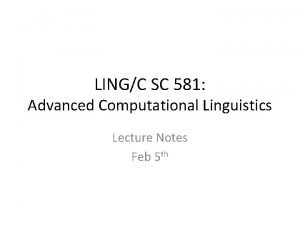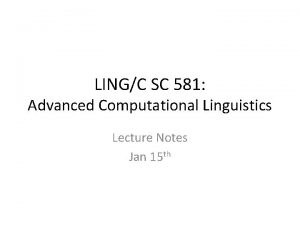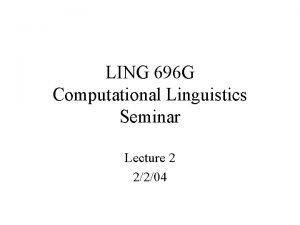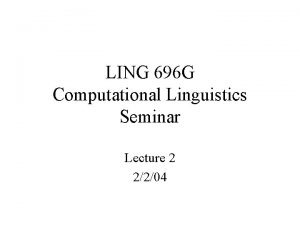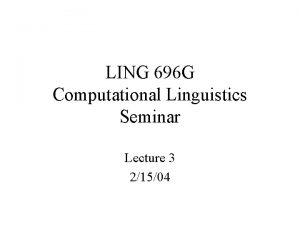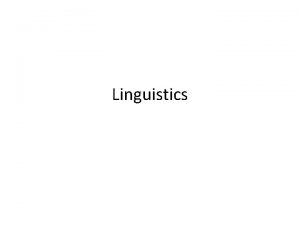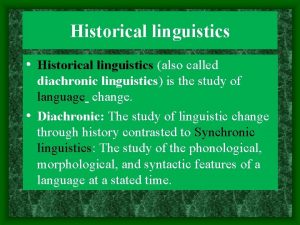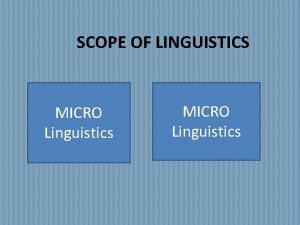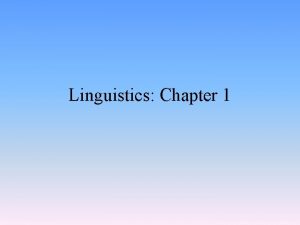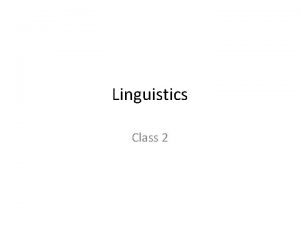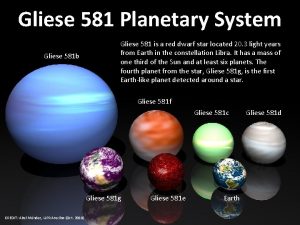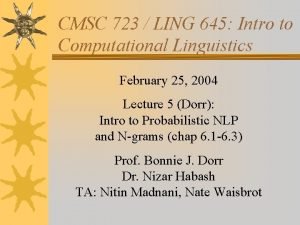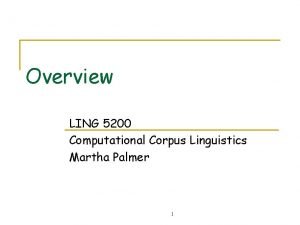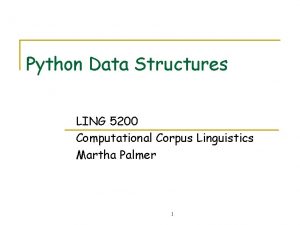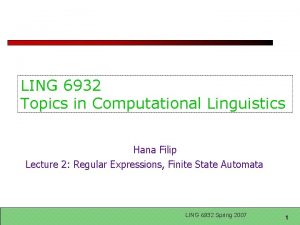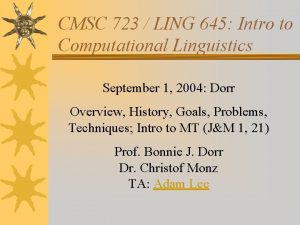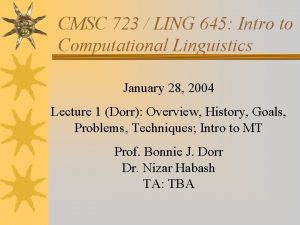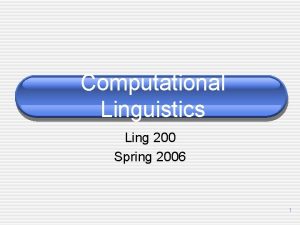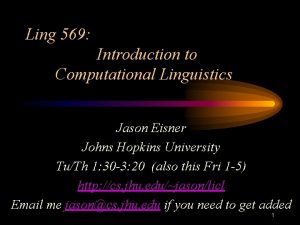LING 581 Advanced Computational Linguistics Lecture Notes April

































































- Slides: 65

LING 581: Advanced Computational Linguistics Lecture Notes April 16 th

Administrivia • Factoid Question Answering homework – did you submit your simulation?

Semantics • New topic! – We want computers to be able to understand sentences, – model the world, – compute meaning, truth values, entailments etc.

Meaning • What is a meaning and how do we represent it? – difficult to pin down precisely for computers – even difficult for humans sometimes… • Example: word dog – by reference to other words • Merriam-Webster: a highly variable domestic mammal (Canis familiaris) closely related to the gray wolf – translation • 犬 (inu, Japanese) = 狗 (gou, Chinese) = “dog” (English) – Computer: • • meaning formal concept (or thought or idea) “dog” maps to DOG <word> maps to <concept> need to provide a concept for every meaningful piece of language?

Understanding • Suppose we write a computer program to compute the meaning of sentences • Question: does it understand sentences? • How do you know? • Ask questions? • Turing test: – converse with a human, convince human the computer is a human • Searle’s Chinese room experiment (adapted) – suppose we have a Perl/Python/Prolog program capable of processing Chinese, and we “run” the program manually – i. e. we carry out the instructions of the program – do we understand Chinese? • Weak AI / Strong AI

Truth Conditions and Values • What is the meaning of a sentence anyway? • What is Meaning? (Portner 2005) • Example: the circle is inside the square – We can draw a picture of scenarios for which the statement is true and the statement is false • Proposition expressed by a sentence is its truthconditions – “under what conditions a sentence is true” – i. e. sets of possible worlds (aka situations) – truth-conditions different from truth-value

Truth Conditions and Values • Example: – The circle is inside the square and the circle is dark – What is the meaning of and here? – and = set intersection (of scenarios) – [The circle is inside the square] and [the circle is dark] • Example: – Mary is a student and a baseball fan – and = set intersection (of ? ? ? ) – Mary is [a student] and [a baseball fan]

Truth Conditions and Values • Example: – Mary and John bought a book – Does and = set intersection? – Are Mary and John sets anyway? – [Mary] and [John] bought a book – Set intersection = ∅ – how about “and = set union” then?

Truth Conditions and Values • Example: – The square is bigger than the circle – The circle is smaller than the square – Are they synonymous? – Are they contradictory? – Is there an entailment relationship? – Are they tautologies?

More examples • 1. Does sleep entail snore? A. He is sleeping entails He is snoring B. He is snoring entails He is sleeping • 2. Does snore presuppose sleep? • 3. What does “when did you stop beating your wife? ” presuppose? • 3. Given the statement “All crows are black”, give an example of a sentence expressing a tautology involving this statement? – Stmt or negation Stmt

Propositional Logic • Recall the distinction between truth conditions and truth values … • Possible world or situation: – we can create a possible world in Prolog by asserting (positive) facts into its database – Prolog use the closed world assumption • i. e. things not explicity stated to be true are assumed to be false

Propositional Logic Cheat sheet • Starting SWI Prolog from Terminal/Shell: – swipl – /opt/local/bin/swipl (if in PATH) (default install location on my mac) ^D (control-D) or halt. to quit

Propositional Logic Cheat sheet • Viewing the database: – listing. • Assert (and delete) facts at the command line directly using predicates: – assert(fact). – retract(fact). • Put facts into a file and load file (assumed to have extension. pl) – (or via pull-down menu in Windows) – [filename]. • Propositions: – named beginning with a lower case letter (not number, not starting with capital letter or underscore: variable – no variables in propositional logic), examples: – assert(p). – p. – dynamic q. (makes p true in this situation) (asks Prolog if p true in this situation) (registers proposition q, prevents error message)

Propositional Logic • Example: Note: meta-level predicates like dynamic and assert evaluate to true if they succeed

Propositional Logic • Propositions can be combined using logical connectives and operators – Conjunction – Disjunction – Negation p , q. p ; q. + p. – Implication p -> q. Use parentheses ( ) to restrict/clarify scope • Not directly implemented in Prolog (IS NOT THIS!!!) can’t add p, q. to the database can only query it needs both p and q to be true, see next slide

Propositional Logic • Help: – ? - help(->). – true. takes a very long time for this window to pop up … it uses the X 11 Window system, which may or may not exist on your system IF -> THEN ; ELSE is a programming construct

Propositional Logic • Also not implemented – Logical equality p = q.

Propositional Logic • Help: Not quite the right documentation page = is unifiability in Prolog

Propositional Logic • Prolog exercise: – evaluate formula below for different truth values of A and B From wikipedia

Propositional Logic • How to demonstrate a propositional formula is a tautology? • One answer: exhaustively enumerate a truth table http: //en. wikipedia. org/wiki/Truth_table

Propositional Logic • Example: (A , B) ; (+ A) ; (+ B) T T F T F T T T F F F T T T F T F F F T T F table has 2 n rows, where n is the number of propositional elements complexity: exponential in n

Propositional Logic • Other connectives (are non-primitive)

Propositional Logic • Other connectives (are non-primitive) aka p↔q • From 1 st and 4 th line of truth table, we can easily deduce how to simulate p ↔ q in Prolog using , ; and +

Propositional Logic Let’s prove the law of contraposition http: //en. wikipedia. org/wiki/Tautology_(logic)

Propositional Logic • Prove both sides of De Morgan’s Laws: Note: De Morgan’s laws tell us we can do without one of conjunction or disjunction. Why?

Propositional Logic • It’s easy to write a short program in Prolog to automate all this … Program: plogic. pl

Propositional Logic • Example using try/2: It's a tautology! true under all possible conditions

Propositional Logic • We can get a bit fancier, support -> and <-> Program: plogic 2. pl

Propositional Logic • We can get even fancier; eliminate having to supply the propositional variables Program: plogic 3. pl

Truth table enumeration • Parsing the formula: 11. + X converts to + A if (subformula) X converts to A 12. X, Y converts to A, B if X converts to A and Y converts to B 13. X; Y converts to A; B if X converts to A and Y converts to B 14. X->Y converts to +A; B if X converts to A and Y converts to B 15. X<->Y converts to (A, B) ; (+A, +B) if X converts to A and Y converts to B 16. X converts to X and add X to the list of propositional variables if it isn’t already in the list

Propositional Logic Program: plogic 3. pl

Semantic Grammars • Use slides from course – LING 324 – Introduction to Semantics – Simon Frasier University, Prof. F. J. Pelletier – http: //www. sfu. ca/~jeffpell/Ling 324/fjp. Slides 4. pdf • Difference is we’re computational linguists… so we’re going to implement the slides • • We’ll do the syntax part this lecture, and the semantics next time

Syntax fjp. Slides 4. pdf Slide 3

Syntax • We already know how to build Prolog grammars • See – http: //www. swiprolog. org/pldoc/doc_for? object=section(2, '4. 12', swi( '/doc/Manual/DCG. html')) for the executive summary

Syntax • Class exercise

Syntax • Step 1: let’s build the simplest possible Prolog grammar for this fjp. Slides 4. pdf Slide 4

Simplest possible grammar g 1. pl Excluding (2 b) for the time being

Simplest possible grammar Examples (3), (4) and (5) from two slides back

Syntax • Step 2: let’s add the parse tree component to our grammar … Recall: grammar rules can have extra arguments (1) Parse tree (2) Implement agreement etc.

Syntax Note: on handling left recursion in Prolog grammar rules • techniques: 1. 2. 3. use a bottom-up parser rewrite grammar or use lookahead (left recursive -> right recursive) (today’s lecture) lookahead is a dummy nonterminal that does not contribute to the parse, it is a “guard” that prevents rule from firing unless appropriate lookahead succeeds if it can find a conjunction in the input and marks it (so it can’t find it twice)

Grammar: version 2 g 2. pl

Grammar: version 2

Grammar: version 2 Examples (3), (4) and (5) again from slide 9

Grammar: version 2 Examples (6) and (7) from slide 9

Semantics • We want to obtain a semantic parse for our sentences that we can “run” (i. e. evaluate) against the Prolog database (i. e. situation or possible world). • So the semantic parse should be valid Prolog code (that we can call) • We’ll need (built-in) member/2 and setof/3 defined in the following 2 slides (a quick review)

setof/3 • See – http: //www. swiprolog. org/pldoc/doc_for? object=section(2, '4. 29', swi('/doc/Manual/al lsolutions. html')) • SWI Prolog built-in:

setof/3 • Example:

member/2 • See – http: //www. swiprolog. org/pldoc/man? predicate=member%2 F 2

Semantics fjp. Slides 4. pdf Slide 7

Semantics fjp. Slides 4. pdf Slide 8

Semantics fjp. Slides 4. pdf Slide 9

Semantics fjp. Slides 4. pdf Slide 10

Semantics: Implementation • Desired implementation: The extra argument returns a Prolog query that can be evaluated against the database Note: we are bypassing the (explicit) construction of the syntax tree Imagine if the Penn Treebank was labeled using a semantic representation

Semantics: Implementation • Let’s write the semantic grammar to handle “Jack is hungry” – first, let’s introduce a bit of notation (lambda calculus) – λ = function – λx. x+1 denotes a function that takes an argument x and computes value x+1 • (a period separates the argument from the function body) – (λx. x+1)(5) means apply 5 to the lambda function • substitute 5 in place of x and evaluate • answer = 6

Semantics: Implementation Syntax: setof(X, hungry(X), S), member(jack, S) jack setof(X, hungry(X), S)

Semantics: Implementation • Semantic grammar:

Semantics: Implementation • Semantic grammar:

Semantics: Implementation • More examples of computation: fjp. Slides 4. pdf Slide 10

Semantics: Implementation • More examples of computation:

Semantics: Implementation • More examples of computation:

Semantics fjp. Slides 4. pdf Slide 11

Semantics: Implementation • Scope of negation: wide or narrow wide

Grammar: version 3 g 3. pl

Grammar: version 3

Evaluation • Check our computer implementation on… fjp. Slides 4. pdf Slide 12
 01:640:244 lecture notes - lecture 15: plat, idah, farad
01:640:244 lecture notes - lecture 15: plat, idah, farad Advanced inorganic chemistry lecture notes
Advanced inorganic chemistry lecture notes Chomsky computational linguistics
Chomsky computational linguistics Xkcd computational linguistics
Xkcd computational linguistics Computational linguistics olympiad
Computational linguistics olympiad Columbia computational linguistics
Columbia computational linguistics Traditional linguistics and modern linguistics
Traditional linguistics and modern linguistics History of applied linguistics
History of applied linguistics Cpsc 581
Cpsc 581 Cpsc 581
Cpsc 581 Cis581
Cis581 Cis 581 upenn
Cis 581 upenn Cpsc 581
Cpsc 581 Cpsc 581
Cpsc 581 581 ad
581 ad Da form 3749 example
Da form 3749 example Supercom 581
Supercom 581 Art 581 cpp
Art 581 cpp Project procurement management lecture notes
Project procurement management lecture notes Theology proper lecture notes
Theology proper lecture notes Public sector definition
Public sector definition 4 p's software engineering
4 p's software engineering Magnetism
Magnetism Physics 111 lecture notes
Physics 111 lecture notes Physical science lecture notes
Physical science lecture notes Power system dynamics and stability lecture notes
Power system dynamics and stability lecture notes Microbial physiology and metabolism lecture notes
Microbial physiology and metabolism lecture notes Mechatronics ppt
Mechatronics ppt Limits fits and tolerances
Limits fits and tolerances Money-time relationship and equivalence
Money-time relationship and equivalence Current components in bjt
Current components in bjt Requirement analysis in software engineering notes
Requirement analysis in software engineering notes Introduction to ofdm
Introduction to ofdm Land use planning lecture notes
Land use planning lecture notes Project quality management lecture notes
Project quality management lecture notes Lecture notes on homiletics
Lecture notes on homiletics Foundation engineering lecture notes
Foundation engineering lecture notes Image processing lecture notes
Image processing lecture notes Intermediate microeconomics lecture notes
Intermediate microeconomics lecture notes Cloud computing lecture
Cloud computing lecture Decision theory lecture notes
Decision theory lecture notes Nonlinear regression lecture notes
Nonlinear regression lecture notes 50f7 tolerance
50f7 tolerance Direct stiffness method truss
Direct stiffness method truss Reservoir and channel routing
Reservoir and channel routing Adf.test in r
Adf.test in r Shape memory alloys lecture notes
Shape memory alloys lecture notes Research methods notes kenyatta university
Research methods notes kenyatta university Financial markets and institutions - ppt
Financial markets and institutions - ppt Physics 101 lecture
Physics 101 lecture Om306
Om306 Nlp lecture notes
Nlp lecture notes Linux lecture notes
Linux lecture notes Dyphilidium caninum
Dyphilidium caninum Introduction to biochemistry lecture notes
Introduction to biochemistry lecture notes Stern-gerlach experiment lecture notes
Stern-gerlach experiment lecture notes Land use planning lecture notes
Land use planning lecture notes Exploratory data analysis lecture notes
Exploratory data analysis lecture notes Slidetodoc downloader
Slidetodoc downloader Principles of interior design ppt
Principles of interior design ppt Bayesian classification in data mining lecture notes
Bayesian classification in data mining lecture notes Data mining lecture notes
Data mining lecture notes Computer architecture notes
Computer architecture notes Franck-condon principle slideshow
Franck-condon principle slideshow Biopotential electrodes lecture notes
Biopotential electrodes lecture notes Erzeng
Erzeng



